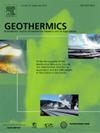巴基斯坦东南部基于Landsat 8、地质和地球物理数据集探测地热异常的综合研究
IF 3.9
2区 工程技术
Q3 ENERGY & FUELS
引用次数: 0
摘要
由于传统化石燃料储量的枯竭和绿色能源的兴起,地热资源勘探作为一个研究热点在全球范围内日益重要。本研究的主要目的是勘探地热潜力,主要集中在巴基斯坦东南部的古新世岩石地热系统。近年来,由于对绿色能源的重视,在全球范围内,利用遥感进行地热异常探测受到了广泛的关注。该研究旨在利用地表温度(LST)数据、地理空间数据集开发地质填图、地球物理测井分析计算产热和岩石物理分析来识别地热异常区域。本文概述了巴基斯坦东南部的地压系统和地热资源的位置,以了解该地区的地热目标。LST值被定量地分为非常高、高、中、低和非常低五类,LST结果表明数据簇分别位于20%、54%、4%、3%和19%。归一化植被指数差异结果显示,研究区96%的面积为裸壤至混合地表,仅4%的面积为全植被。岩石物理结果表明,研究井的Ranikot组有效孔隙度范围为20 - 24%,表明其可能是增强型地热系统(EGS)的候选层。通过盆地建模,绘制了地下热流(109-113 mW/m2)、温度(60-150°C)和有效孔隙度(22 - 24%)分布图。利用浓度数(CN)模型和对数对数图技术绘制伽马和产热值,将地热异常及其空间相关性与背景分离开来。在地热储层中,EGS等开发地热能源和降低勘探风险的技术的不断进步在经济上至关重要。这些创新吸引了研究人员探索地热能源的潜力。然而,它们的成功实施主要依赖于对盆地当地地质条件的深入了解。本文章由计算机程序翻译,如有差异,请以英文原文为准。
An integrated study to detect geothermal anomalies based on Landsat 8, Geological, and Geophysical data sets in Southeast Pakistan
Geothermal resource exploration has grown in importance globally as a research hotspot due to the depletion of conventional fossil fuel reserves and green energy initiatives. This research's prime objective is to explore the geothermal potential, primarily focused on the Paleocene rock geothermal systems in Southeast Pakistan. Globally, the use of remote sensing for geothermal anomaly detection has gained much attention recently due to the increased focus on green energy. This study aimed to identify regions with geothermal anomalies using land surface temperature (LST) data, a geospatial dataset to develop geological mapping, and geophysical well logs analysis to compute heat production and petrophysical analysis. An overview of geo-pressurized systems and geothermal resources’ location in Southeast Pakistan has been provided to get an idea of the geothermal target in this region. The LST values were quantitatively classified into five categories: very high, high, medium, low, and very low, and LST results indicate that the data cluster lies in 20 %, 54 %, 4 %, 3 %, and 19 %, respectively. Normalized difference vegetation index results showed that 96 % of the study area lies in bare soil to mixed surface, and only 4 % of the region lies in full vegetation. Petrophysics results indicate that the Ranikot Formation has very good effective porosity ranges of 20–24 % in the studied wells, suggesting a potential candidate for enhanced geothermal systems (EGS). Basin modeling was performed to delineate subsurface heat flow (109–113 mW/m2), temperature (60–150 °C), and effective porosity (22–24 %) distribution mapping. The concentration number (C![]() N) model and log-log plots techniques were employed to map gamma-ray and heat production values to separate the geothermal anomaly and spatial correlation from its background. Emerging advancements in technologies such as EGS for exploiting geothermal energy and reducing exploration risk are crucial economically in geothermal reservoirs. These innovations have attracted researchers to explore the potential to utilize geothermal energy significantly. Still, their successful implementation principally relies on an in-depth understanding of the local geological conditions of the basin.
N) model and log-log plots techniques were employed to map gamma-ray and heat production values to separate the geothermal anomaly and spatial correlation from its background. Emerging advancements in technologies such as EGS for exploiting geothermal energy and reducing exploration risk are crucial economically in geothermal reservoirs. These innovations have attracted researchers to explore the potential to utilize geothermal energy significantly. Still, their successful implementation principally relies on an in-depth understanding of the local geological conditions of the basin.
求助全文
通过发布文献求助,成功后即可免费获取论文全文。
去求助
来源期刊

Geothermics
工程技术-地球科学综合
CiteScore
7.70
自引率
15.40%
发文量
237
审稿时长
4.5 months
期刊介绍:
Geothermics is an international journal devoted to the research and development of geothermal energy. The International Board of Editors of Geothermics, which comprises specialists in the various aspects of geothermal resources, exploration and development, guarantees the balanced, comprehensive view of scientific and technological developments in this promising energy field.
It promulgates the state of the art and science of geothermal energy, its exploration and exploitation through a regular exchange of information from all parts of the world. The journal publishes articles dealing with the theory, exploration techniques and all aspects of the utilization of geothermal resources. Geothermics serves as the scientific house, or exchange medium, through which the growing community of geothermal specialists can provide and receive information.
 求助内容:
求助内容: 应助结果提醒方式:
应助结果提醒方式:


